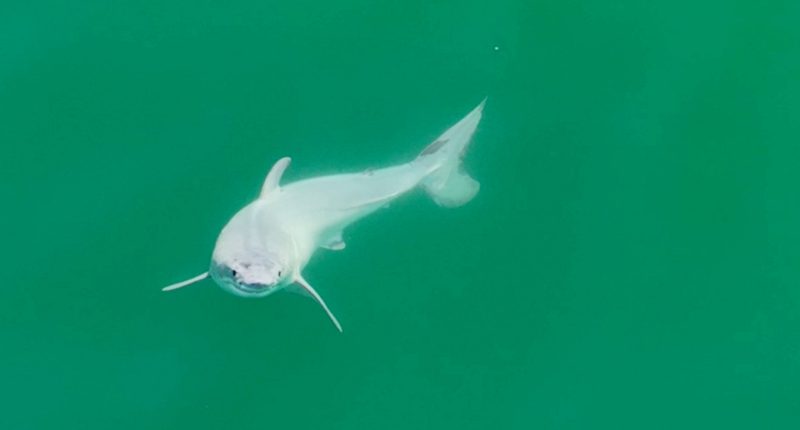THE first-ever picture of a newborn great white shark has been released, leaving scientists stunned at the breakthrough discovery.
The baby shark may have been just a few hours old, according to experts – making it the first ever great white shark to be seen so soon after birth.
Scientists have previously only seen older shark pups or found baby great whites dead inside their deceased pregnant mothers.
But never has a great white shark been spotted so early in its lifecycle.
The spectacular image was captured by wildlife filmmaker Carols Gauna and UC Riverside PhD student Phillip Sternes on 9 July 2023 in Santa Barbara, California.
While scouting the waters for sharks, the pair found something unusual on their drone camera’s viewfinder.
more on sharks
It was a great white shark pup – but unlike any they had ever seen before.
Usually, great whites – the largest predatory sharks in the world – are grey on top and white on the bottom.
But this shark, which measured around five feet, was pure white.
Sternes said: “We enlarged the images, put them in slow motion, and realised the white layer was being shed from the body as it was swimming.
Most read in Science
“I believe it was a newborn white shark shedding its embryonic layer.”
The pair, however, have acknowledged the possibility of a skin condition for the baby white shark’s shedding.
Gauna added: “If that is what we saw [shedding due to skin condition], then that too is monumental, because no such condition has ever been reported for these sharks.”
But they do not believe this to be the case and are instead convinced that their sighting was of a newborn great white.
And they have set out the reasons for this in their paper, which has been published in the journal Environmental Biology of Fishes.
The PhD candidate explained: “Our first evidence is that great white females give birth to live pups.
“While in utero, the embryonic sharks might feed on unfertilised eggs for protein.
“The mothers offer additional nourishment to the growing shark pups with a ‘milk’ secreted in the uterus.
“I believe what we saw was the baby shedding the intrauterine milk.”
The second reason he gave was the shark’s size and shape.
It was thin, short, and rounded, which the researchers took as indicative of it being a newborn.
“In my opinion, this one was likely hours, maybe one day old at most,” Mr Sternes said.
Finally, large, likely pregnant sharks have been spotted in this area for years – many observed and filmed by Gauna himself.
The location has therefore long been proposed as a birthing location for great whites, but there has previously been no evidence.
“I filmed three very large sharks that appeared pregnant at this specific location in the days prior,” he said.
“On this day, one of them dove down, and not long afterwards, this fully white shark appeared.
“It’s not a stretch to deduce where the baby came from.
“This may well be the first evidence we have of a pup in the wild, making this a definitive birthing location.”
This rare sighting, according to the wildlife filmmaker, could offer new insights into where great whites give birth, which has long been a mystery in shark science.
He said: “Where white sharks give birth is one of the holy grails of shark science.
READ MORE SUN STORIES
“No one has ever been able to pinpoint where they are born, nor has anyone seen a newborn baby shark alive.
“There have been dead white sharks found inside deceased pregnant mothers. But nothing like this.”
How do sharks give birth?

SHARK reproduction is different from most fish – and happens through internal fertilization across all species.
The sea predators invest a lot of energy into producing well-developed embryos that have good chances of survival.
Oviparity, or egg-laying, is one of the most common ways through which sharks reproduce.
Some shark species produce eggs encased in a tough ‘leathery’ eggcase.
A female may spend a long time laying her eggs, ensuring they’re securely fixed in a safe place. It can take between 6-9 months before they’re ready to hatch.
The protective capsule acts as a life-support machine, containing everything that’s needed.
The embryo absorbs nutrients from a yolk sac before hatching – and emerges as a miniature version of the adult.
Oviviparity is another form of shark reproduction where the female carries eggs inside her body instead of laying them, providing extra safety from potential predators.
The embryos develop within an eggcase that has a thin membrane.
Once developed the baby shark will hatch inside her mother, who will then give birth to the young offspring.
Viviparity, also called live birth, is the third and most advanced method of reproduction in sharks.
The baby shark develops inside their mother’s body, receiving nutrients and oxygen through an umbilical cord – just like other mammals.
However, when the pups are born, they’re immediately independent – and have to fend for themselves.











